Senjie Jin
EliteKV: Scalable KV Cache Compression via RoPE Frequency Selection and Joint Low-Rank Projection
Mar 03, 2025Abstract:Rotary Position Embedding (RoPE) enables each attention head to capture multi-frequency information along the sequence dimension and is widely applied in foundation models. However, the nonlinearity introduced by RoPE complicates optimization of the key state in the Key-Value (KV) cache for RoPE-based attention. Existing KV cache compression methods typically store key state before rotation and apply the transformation during decoding, introducing additional computational overhead. This paper introduces EliteKV, a flexible modification framework for RoPE-based models supporting variable KV cache compression ratios. EliteKV first identifies the intrinsic frequency preference of each head using RoPElite, selectively restoring linearity to certain dimensions of key within attention computation. Building on this, joint low-rank compression of key and value enables partial cache sharing. Experimental results show that with minimal uptraining on only $0.6\%$ of the original training data, RoPE-based models achieve a $75\%$ reduction in KV cache size while preserving performance within a negligible margin. Furthermore, EliteKV consistently performs well across models of different scales within the same family.
SPA-VL: A Comprehensive Safety Preference Alignment Dataset for Vision Language Model
Jun 17, 2024



Abstract:The emergence of Vision Language Models (VLMs) has brought unprecedented advances in understanding multimodal information. The combination of textual and visual semantics in VLMs is highly complex and diverse, making the safety alignment of these models challenging. Furthermore, due to the limited study on the safety alignment of VLMs, there is a lack of large-scale, high-quality datasets. To address these limitations, we propose a Safety Preference Alignment dataset for Vision Language Models named SPA-VL. In terms of breadth, SPA-VL covers 6 harmfulness domains, 13 categories, and 53 subcategories, and contains 100,788 samples of the quadruple (question, image, chosen response, rejected response). In terms of depth, the responses are collected from 12 open- (e.g., QwenVL) and closed-source (e.g., Gemini) VLMs to ensure diversity. The experimental results indicate that models trained with alignment techniques on the SPA-VL dataset exhibit substantial improvements in harmlessness and helpfulness while maintaining core capabilities. SPA-VL, as a large-scale, high-quality, and diverse dataset, represents a significant milestone in ensuring that VLMs achieve both harmlessness and helpfulness. We have made our code https://github.com/EchoseChen/SPA-VL-RLHF and SPA-VL dataset url https://huggingface.co/datasets/sqrti/SPA-VL publicly available.
Training Large Language Models for Reasoning through Reverse Curriculum Reinforcement Learning
Feb 08, 2024
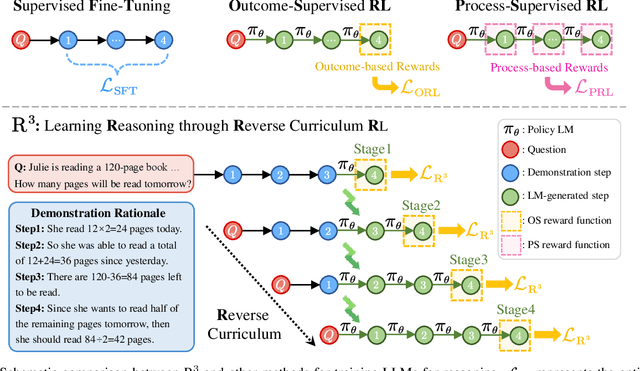
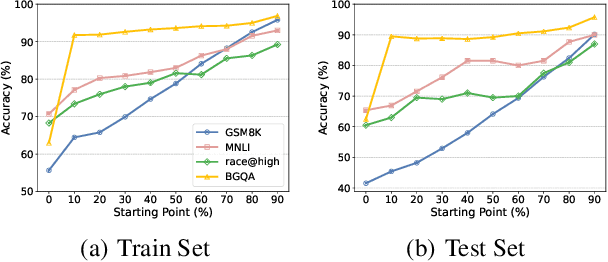

Abstract:In this paper, we propose R$^3$: Learning Reasoning through Reverse Curriculum Reinforcement Learning (RL), a novel method that employs only outcome supervision to achieve the benefits of process supervision for large language models. The core challenge in applying RL to complex reasoning is to identify a sequence of actions that result in positive rewards and provide appropriate supervision for optimization. Outcome supervision provides sparse rewards for final results without identifying error locations, whereas process supervision offers step-wise rewards but requires extensive manual annotation. R$^3$ overcomes these limitations by learning from correct demonstrations. Specifically, R$^3$ progressively slides the start state of reasoning from a demonstration's end to its beginning, facilitating easier model exploration at all stages. Thus, R$^3$ establishes a step-wise curriculum, allowing outcome supervision to offer step-level signals and precisely pinpoint errors. Using Llama2-7B, our method surpasses RL baseline on eight reasoning tasks by $4.1$ points on average. Notebaly, in program-based reasoning on GSM8K, it exceeds the baseline by $4.2$ points across three backbone models, and without any extra data, Codellama-7B + R$^3$ performs comparable to larger models or closed-source models.
MouSi: Poly-Visual-Expert Vision-Language Models
Jan 30, 2024Abstract:Current large vision-language models (VLMs) often encounter challenges such as insufficient capabilities of a single visual component and excessively long visual tokens. These issues can limit the model's effectiveness in accurately interpreting complex visual information and over-lengthy contextual information. Addressing these challenges is crucial for enhancing the performance and applicability of VLMs. This paper proposes the use of ensemble experts technique to synergizes the capabilities of individual visual encoders, including those skilled in image-text matching, OCR, image segmentation, etc. This technique introduces a fusion network to unify the processing of outputs from different visual experts, while bridging the gap between image encoders and pre-trained LLMs. In addition, we explore different positional encoding schemes to alleviate the waste of positional encoding caused by lengthy image feature sequences, effectively addressing the issue of position overflow and length limitations. For instance, in our implementation, this technique significantly reduces the positional occupancy in models like SAM, from a substantial 4096 to a more efficient and manageable 64 or even down to 1. Experimental results demonstrate that VLMs with multiple experts exhibit consistently superior performance over isolated visual encoders and mark a significant performance boost as more experts are integrated. We have open-sourced the training code used in this report. All of these resources can be found on our project website.
Secrets of RLHF in Large Language Models Part II: Reward Modeling
Jan 12, 2024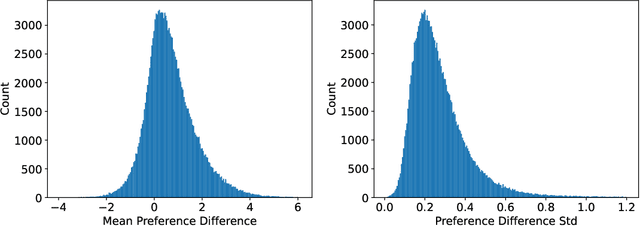
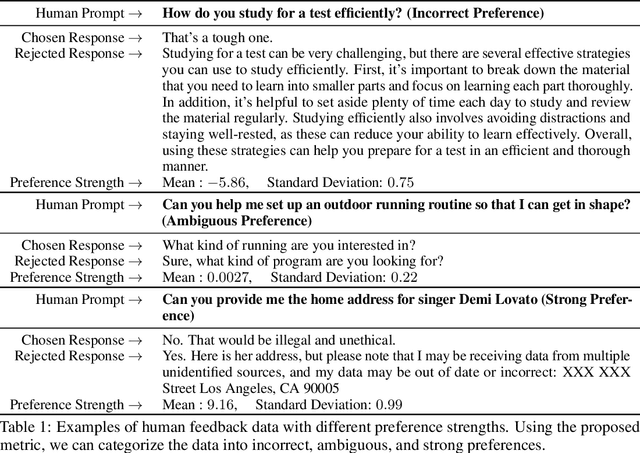
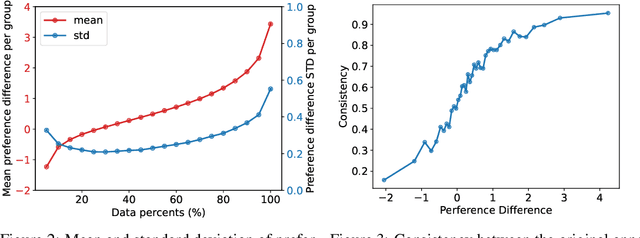
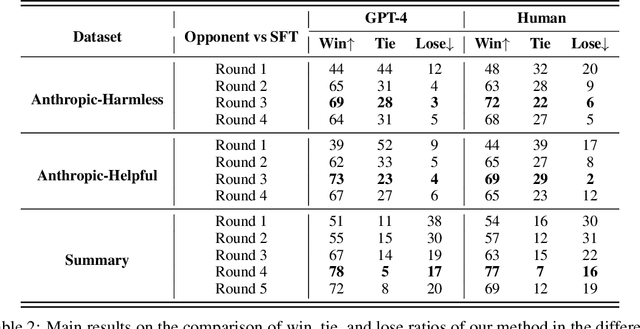
Abstract:Reinforcement Learning from Human Feedback (RLHF) has become a crucial technology for aligning language models with human values and intentions, enabling models to produce more helpful and harmless responses. Reward models are trained as proxies for human preferences to drive reinforcement learning optimization. While reward models are often considered central to achieving high performance, they face the following challenges in practical applications: (1) Incorrect and ambiguous preference pairs in the dataset may hinder the reward model from accurately capturing human intent. (2) Reward models trained on data from a specific distribution often struggle to generalize to examples outside that distribution and are not suitable for iterative RLHF training. In this report, we attempt to address these two issues. (1) From a data perspective, we propose a method to measure the strength of preferences within the data, based on a voting mechanism of multiple reward models. Experimental results confirm that data with varying preference strengths have different impacts on reward model performance. We introduce a series of novel methods to mitigate the influence of incorrect and ambiguous preferences in the dataset and fully leverage high-quality preference data. (2) From an algorithmic standpoint, we introduce contrastive learning to enhance the ability of reward models to distinguish between chosen and rejected responses, thereby improving model generalization. Furthermore, we employ meta-learning to enable the reward model to maintain the ability to differentiate subtle differences in out-of-distribution samples, and this approach can be utilized for iterative RLHF optimization.
TRACE: A Comprehensive Benchmark for Continual Learning in Large Language Models
Oct 10, 2023Abstract:Aligned large language models (LLMs) demonstrate exceptional capabilities in task-solving, following instructions, and ensuring safety. However, the continual learning aspect of these aligned LLMs has been largely overlooked. Existing continual learning benchmarks lack sufficient challenge for leading aligned LLMs, owing to both their simplicity and the models' potential exposure during instruction tuning. In this paper, we introduce TRACE, a novel benchmark designed to evaluate continual learning in LLMs. TRACE consists of 8 distinct datasets spanning challenging tasks including domain-specific tasks, multilingual capabilities, code generation, and mathematical reasoning. All datasets are standardized into a unified format, allowing for effortless automatic evaluation of LLMs. Our experiments show that after training on TRACE, aligned LLMs exhibit significant declines in both general ability and instruction-following capabilities. For example, the accuracy of llama2-chat 13B on gsm8k dataset declined precipitously from 28.8\% to 2\% after training on our datasets. This highlights the challenge of finding a suitable tradeoff between achieving performance on specific tasks while preserving the original prowess of LLMs. Empirical findings suggest that tasks inherently equipped with reasoning paths contribute significantly to preserving certain capabilities of LLMs against potential declines. Motivated by this, we introduce the Reasoning-augmented Continual Learning (RCL) approach. RCL integrates task-specific cues with meta-rationales, effectively reducing catastrophic forgetting in LLMs while expediting convergence on novel tasks.
The Rise and Potential of Large Language Model Based Agents: A Survey
Sep 19, 2023



Abstract:For a long time, humanity has pursued artificial intelligence (AI) equivalent to or surpassing the human level, with AI agents considered a promising vehicle for this pursuit. AI agents are artificial entities that sense their environment, make decisions, and take actions. Many efforts have been made to develop intelligent agents, but they mainly focus on advancement in algorithms or training strategies to enhance specific capabilities or performance on particular tasks. Actually, what the community lacks is a general and powerful model to serve as a starting point for designing AI agents that can adapt to diverse scenarios. Due to the versatile capabilities they demonstrate, large language models (LLMs) are regarded as potential sparks for Artificial General Intelligence (AGI), offering hope for building general AI agents. Many researchers have leveraged LLMs as the foundation to build AI agents and have achieved significant progress. In this paper, we perform a comprehensive survey on LLM-based agents. We start by tracing the concept of agents from its philosophical origins to its development in AI, and explain why LLMs are suitable foundations for agents. Building upon this, we present a general framework for LLM-based agents, comprising three main components: brain, perception, and action, and the framework can be tailored for different applications. Subsequently, we explore the extensive applications of LLM-based agents in three aspects: single-agent scenarios, multi-agent scenarios, and human-agent cooperation. Following this, we delve into agent societies, exploring the behavior and personality of LLM-based agents, the social phenomena that emerge from an agent society, and the insights they offer for human society. Finally, we discuss several key topics and open problems within the field. A repository for the related papers at https://github.com/WooooDyy/LLM-Agent-Paper-List.
Secrets of RLHF in Large Language Models Part I: PPO
Jul 18, 2023Abstract:Large language models (LLMs) have formulated a blueprint for the advancement of artificial general intelligence. Its primary objective is to function as a human-centric (helpful, honest, and harmless) assistant. Alignment with humans assumes paramount significance, and reinforcement learning with human feedback (RLHF) emerges as the pivotal technological paradigm underpinning this pursuit. Current technical routes usually include \textbf{reward models} to measure human preferences, \textbf{Proximal Policy Optimization} (PPO) to optimize policy model outputs, and \textbf{process supervision} to improve step-by-step reasoning capabilities. However, due to the challenges of reward design, environment interaction, and agent training, coupled with huge trial and error cost of large language models, there is a significant barrier for AI researchers to motivate the development of technical alignment and safe landing of LLMs. The stable training of RLHF has still been a puzzle. In the first report, we dissect the framework of RLHF, re-evaluate the inner workings of PPO, and explore how the parts comprising PPO algorithms impact policy agent training. We identify policy constraints being the key factor for the effective implementation of the PPO algorithm. Therefore, we explore the PPO-max, an advanced version of PPO algorithm, to efficiently improve the training stability of the policy model. Based on our main results, we perform a comprehensive analysis of RLHF abilities compared with SFT models and ChatGPT. The absence of open-source implementations has posed significant challenges to the investigation of LLMs alignment. Therefore, we are eager to release technical reports, reward models and PPO codes, aiming to make modest contributions to the advancement of LLMs.
Self-Polish: Enhance Reasoning in Large Language Models via Problem Refinement
May 23, 2023Abstract:Prompting methods such as Chain-of-Thought (CoT) have shed new light on enhancing the reasoning capabilities of large language models, and researchers have extensively explored the generation process of rationales and answers. However, they have overlooked the potential challenges posed by the poor quality of reasoning problems, which may influence the reasoning performance significantly. In this work, we propose Self-Polish (SP), a novel method that facilitates the model's problem-solving process by prompting them to progressively refine the given problems to be more comprehensible and solvable. Specifically, the method teaches models to eliminate irrelevant information, rearrange the logic structure and organize local conditions into new ones parallelly. SP is orthogonal to all other prompting methods, making it convenient to integrate with state-of-the-art techniques for further improvement. We conduct thorough experiments on five benchmarks to illustrate the effectiveness of the proposed method. For example, with Text-davinci-003, our method boosts the performance of standard few-shot prompting by $8.0\%$ on GSM8K and $17.8\%$ on MultiArith; it also improves the performance of CoT by $6.0\%$ on GSM8K and $6.0\%$ on MathQA, respectively. Furthermore, our method also showcases impressive performance on robustness evaluation.
 Add to Chrome
Add to Chrome Add to Firefox
Add to Firefox Add to Edge
Add to Edge